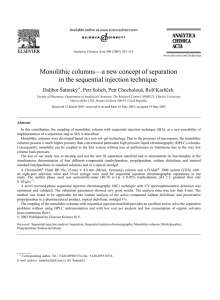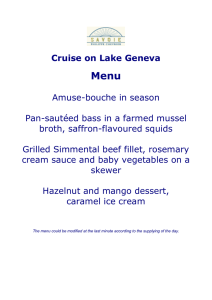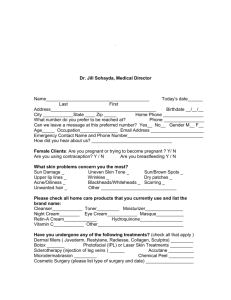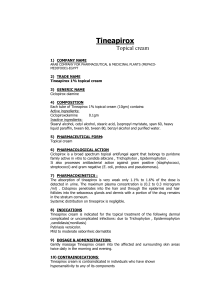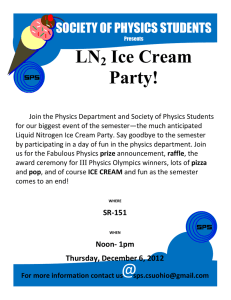Document 13309350
advertisement
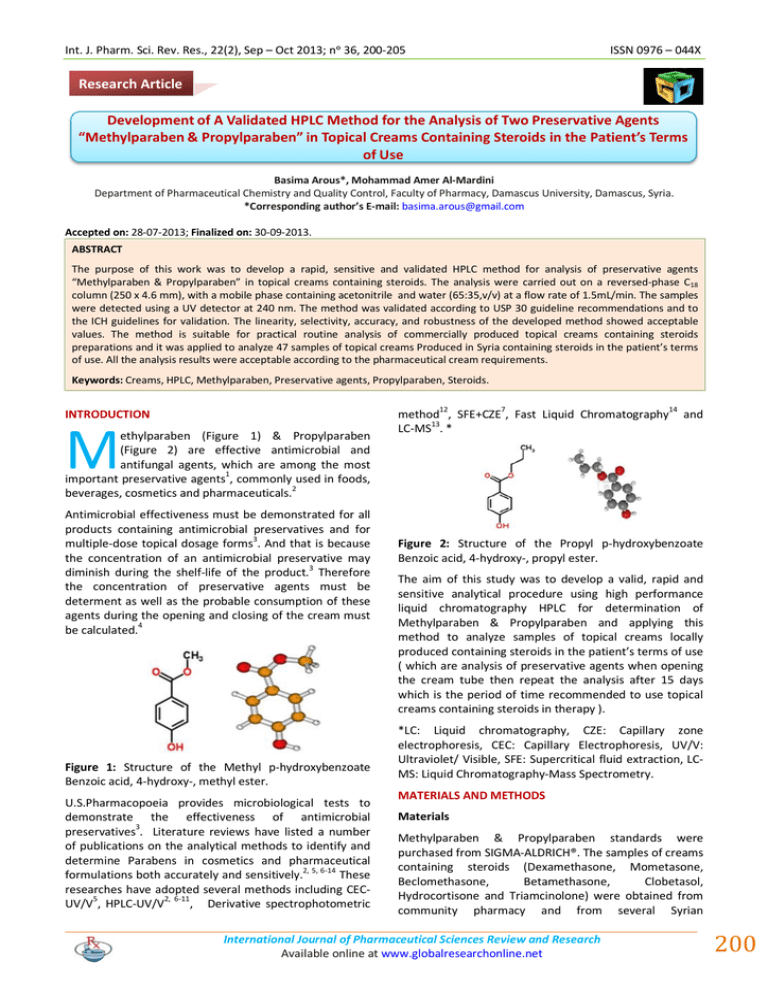
Int. J. Pharm. Sci. Rev. Res., 22(2), Sep – Oct 2013; nᵒ 36, 200-205 ISSN 0976 – 044X Research Article Development of A Validated HPLC Method for the Analysis of Two Preservative Agents “Methylparaben & Propylparaben” in Topical Creams Containing Steroids in the Patient’s Terms of Use Basima Arous*, Mohammad Amer Al-Mardini Department of Pharmaceutical Chemistry and Quality Control, Faculty of Pharmacy, Damascus University, Damascus, Syria. *Corresponding author’s E-mail: basima.arous@gmail.com Accepted on: 28-07-2013; Finalized on: 30-09-2013. ABSTRACT The purpose of this work was to develop a rapid, sensitive and validated HPLC method for analysis of preservative agents “Methylparaben & Propylparaben” in topical creams containing steroids. The analysis were carried out on a reversed-phase C18 column (250 x 4.6 mm), with a mobile phase containing acetonitrile and water (65:35,v/v) at a flow rate of 1.5mL/min. The samples were detected using a UV detector at 240 nm. The method was validated according to USP 30 guideline recommendations and to the ICH guidelines for validation. The linearity, selectivity, accuracy, and robustness of the developed method showed acceptable values. The method is suitable for practical routine analysis of commercially produced topical creams containing steroids preparations and it was applied to analyze 47 samples of topical creams Produced in Syria containing steroids in the patient’s terms of use. All the analysis results were acceptable according to the pharmaceutical cream requirements. Keywords: Creams, HPLC, Methylparaben, Preservative agents, Propylparaben, Steroids. INTRODUCTION M ethylparaben (Figure 1) & Propylparaben (Figure 2) are effective antimicrobial and antifungal agents, which are among the most important preservative agents1, commonly used in foods, beverages, cosmetics and pharmaceuticals.2 Antimicrobial effectiveness must be demonstrated for all products containing antimicrobial preservatives and for multiple-dose topical dosage forms3. And that is because the concentration of an antimicrobial preservative may diminish during the shelf-life of the product.3 Therefore the concentration of preservative agents must be determent as well as the probable consumption of these agents during the opening and closing of the cream must 4 be calculated. Figure 1: Structure of the Methyl p-hydroxybenzoate Benzoic acid, 4-hydroxy-, methyl ester. U.S.Pharmacopoeia provides microbiological tests to demonstrate the effectiveness of antimicrobial preservatives3. Literature reviews have listed a number of publications on the analytical methods to identify and determine Parabens in cosmetics and pharmaceutical formulations both accurately and sensitively.2, 5, 6-14 These researches have adopted several methods including CEC5 2, 6-11 UV/V , HPLC-UV/V , Derivative spectrophotometric method12, SFE+CZE7, Fast Liquid Chromatography14 and LC-MS13. * Figure 2: Structure of the Propyl p-hydroxybenzoate Benzoic acid, 4-hydroxy-, propyl ester. The aim of this study was to develop a valid, rapid and sensitive analytical procedure using high performance liquid chromatography HPLC for determination of Methylparaben & Propylparaben and applying this method to analyze samples of topical creams locally produced containing steroids in the patient’s terms of use ( which are analysis of preservative agents when opening the cream tube then repeat the analysis after 15 days which is the period of time recommended to use topical creams containing steroids in therapy ). *LC: Liquid chromatography, CZE: Capillary zone electrophoresis, CEC: Capillary Electrophoresis, UV/V: Ultraviolet/ Visible, SFE: Supercritical fluid extraction, LCMS: Liquid Chromatography-Mass Spectrometry. MATERIALS AND METHODS Materials Methylparaben & Propylparaben standards were purchased from SIGMA-ALDRICH®. The samples of creams containing steroids (Dexamethasone, Mometasone, Beclomethasone, Betamethasone, Clobetasol, Hydrocortisone and Triamcinolone) were obtained from community pharmacy and from several Syrian International Journal of Pharmaceutical Sciences Review and Research Available online at www.globalresearchonline.net 200 Int. J. Pharm. Sci. Rev. Res., 22(2), Sep – Oct 2013; nᵒ 36, 200-205 pharmaceutical factories. Solvents especially for HPLC (acetonitrile, water and ethanol) were purchased from the Merck and Panreac companies. Instruments and equipment Hitachi HPLC Model organizer provided with UV-Vis Detector L-2420, two pumps A & B: L-2130, column oven L-2350, manual injector P/N7725i, EZChrom Elite for Hitachi Version 3179 and with Macherey-Negal Column C18 (250mmx4.6mm). Mettler sensitive analytical balance -4 (sensitivity of 10 g). Martin Christ Osterode/Harz Centrifuge (0-6000 r/min). Metrohm pH meter. Baird & Tatlock Magnetic stirrer. Helium gas cylinder. Bechers, Volumetric flasks, Pipettes and Glassware of different volumes from Marienfeld Company. Filters PVDF 0.45µm for HPLC purchased from TEKNOKROMA. Chromatographic conditions The mobile phase consisted of acetonitrile and water (65:35, v/v), the detector wavelength was 240nm. The flow rate was maintained at 1.5mL/min. The column temperature was at 25°C. The injection volume was 20 µl. ISSN 0976 – 044X and placed in a 200 ml volumetric flask. It was dissolved in appropriate amount of ethanol 50% (1:1, v/v ethanol: water) and complete to 200 ml volume with ethanol 50%. Following the same procedure, 0.5mg/ml stock solution of Propylparaben was prepared. Preparation of standard solutions Standard solution of 0.05mg/ml Methylparaben was prepared by taking 4ml of 0.5mg/ml Methyl paraben Stock solution and adding accurately 36ml of ethanol 50%. Following the same procedure, standard solution of 0.05mg/ml Propylparaben was prepared. Preparation of the standard mixture solutions of Methylparaben & Propylparaben 4ml Of each of the Stock solution of Methylparaben & Propylparaben were mixed together, then 32ml of ethanol 50% were added to get the mixture solution of 0.05mg/ml Methylparaben & Propylparaben. Preparation of solutions for validation study Standard solutions for linearity study They were prepared from the Stock solutions of Methylparaben & Propylparaben and diluted with ethanol 50% as it is shown in Table 1. Preparation of solutions Preparation of stock solutions 0.5mg/ml Stock solution of Methylparaben was prepared by taking 100 mg of Methylparaben accurately weighed Table 1: Preparation of Standard solutions for linearity study Preservatives concentration % Preservatives concentration mg/20ml The volume transferred from Methylparaben stock solution ml The volume transferred from Propylparaben stock solution ml The volume of ethanol 50% added ml 20 0.2 0.8 0.8 38.4 50 0.5 2 2 36 100 1 4 4 32 200 2 8 8 24 500 5 20 20 0 Solutions for robustness study Solutions for accuracy study Creams excipients were spiked to the standard solutions to obtain analyzed samples. Nine samples were divided into three groups containing respectively 80%, 100% and 120% of standard solution concentration. Three cream samples containing 100% of standard solution concentration were also analyzed. The first sample was injected after adjusting the flow rate to 1.4ml/min, second to 1.5ml/min and the third to 1.6ml/min. Solutions for precision study Preparation of samples Cream samples were analyzed. Nine samples were prepared and divided into three groups containing respectively 80%, 100% and 120% of standard solution concentration. 2g of cream accurately weighed were transferred to a 50ml screw-capped centrifuge’s tube. 40 ml of ethanol 50% were added, and mixed using a magnetic stirrer for 20 min, and then it was centrifuged at 2500 rpm for 10 min. 10ml of the clear supernatant layer were transferred to a volumetric flask. Solutions for selectivity study A preservative-free sample was prepared from the cream excipients. Three cream samples containing 100% of standard solution concentration were also analyzed. Preparation of mobile phase Mobile phase is a mixture of acetonitrile: water (65:35, v/v) and it was filtered through HPLC specific filters also it was degasses by using Helium gas cylinder. International Journal of Pharmaceutical Sciences Review and Research Available online at www.globalresearchonline.net 201 Int. J. Pharm. Sci. Rev. Res., 22(2), Sep – Oct 2013; nᵒ 36, 200-205 ISSN 0976 – 044X RESULTS Selection of mobile phase and experimental conditions Method development As it is shown in Table 2, two different combinations of the mobile phase were tested until the suitable phase, Acetonitrile: water (65:35, v/v) was reached. Wavelength selection A wavelength of 240 nm was selected after scanning between 200-400 nm. Table 2: Mobile phases were tested Acetonitrile: Water Ethanol: Water 30:70 30:70 40:60 40:60 50:50 50:50 60:40 60:40 70:30 70:30 65:35 - Result There were two separated peaks and the best result was when using Acetonitrile 65%, Resolution was > 4, and the tailing factor was 0.8,1.0 for Methylparaben & Propylparaben respectively and the retention time was 3.5 for Methylparaben and 4.9 for Propylparaben when 1.5ml/min flow-rate were used (Figure 3). Result There were two peaks with the tailing factor 0.9, 1.0 for Methylparaben & Propylparaben respectively. The peaks were not separated until using ethanol 70% but the Resolution was <1. Figure 3: Chromatogram of Methylparaben & Propylparaben using Acetonitrile: Water (65:35,v/v) as mobile phase with a flow- rate of 1.5ml/min Figure 4: The concentration of Methylparaben in mg/g cream International Journal of Pharmaceutical Sciences Review and Research Available online at www.globalresearchonline.net 202 Int. J. Pharm. Sci. Rev. Res., 22(2), Sep – Oct 2013; nᵒ 36, 200-205 ISSN 0976 – 044X Table 3: features the most important constitutional standards in the chromatogram of a mixture of Methylparaben & Propylparaben. Compound Area Theoretical plates TH.P.(N) Tailing factor T.F. Resolution Retention time Methylparaben 109 169 66 2532 0.83 - 3.5 Propylparaben 9 663 907 4230 1.00 4.279 4.9 Table 4: Summarizes the results of the method validation tests. Validation results Methylparaben Propylparaben r : 0.9999 r :0.9998 Slope : 10834904.6 Slope : 9662986.5 KF : 10834268.6 KF : 9663138.4 R : 6031.07 R :-108.53 Accuracy Recovery (%) : 100.27 Recovery (%) : 100.36 Selectivity Recovery (%) : 100.25 Recovery (%) : 100.02 Recovery(%) : 100.14 Recovery(%) : 100.26 Linearity Repeatability SD : 0.34 SD : 0.26 RSD : 0.34 RSD : 0.26 Recovery(%) : 100.14 Recovery(%) : 100.35 SD : 0.25 SD : 0.41 RSD : 0.25 RSD : 0.41 1.4ml/min Recovery(%) : 99.23 Retention time : 4.6 Recovery(%) : 99.62 Retention time : 5.3 1.5ml/min Recovery(%) : 98.67 Retention time : 3.5 Recovery(%) : 99.43 Retention time : 4.9 Recovery(%) : 106.55 Retention time : 3.1 Recovery(%) : 106.54 Retention time : 4.2 Precision Intermediate Precision Robustness (Flow Rate) 1.6ml/min KF: Response Factor; R: Residual Factor; r: correlation Factor; RSD: Relative standard deviation; SD: Standard deviation Figure 5: The concentration of Propylparaben in mg/g cream International Journal of Pharmaceutical Sciences Review and Research Available online at www.globalresearchonline.net 203 Int. J. Pharm. Sci. Rev. Res., 22(2), Sep – Oct 2013; nᵒ 36, 200-205 Selection of flow-rate The increasing flow-rate from 1ml/min to 1.5ml/min showed a decrease in the retention time. Sufficient flowrate of 1.5ml/min was chosen to avoid overlap between peaks and the loss of its acceptable resolution values. Validation of the method Identity of each peak was confirmed by their retention time. Method compatibility with the requirements of system suitability according to the standards of 3 U.S.Pharmacopoeia was performed, and also based on the requirements of ICH guidelines for validation of analytical procedures15. The calibration curve linearity was examined by studying the correlation coefficient between the concentrations and the response area of each concentration. Accuracy was assessed by the recovery percentage. Relative standard deviations for selectivity, repeatability, intermediate precision and robustness were less than 2%. Values of detection limits (0.25 µg/ml for Methylparaben & 0.22 µg/ml for Propylparaben) and quantification limits (0.75 µg/ml for Methylparaben & 0.66 µg/ml for Propylparaben) indicate a good sensitivity of the method. ISSN 0976 – 044X range of (0.2-5) mg/20ml for both Methylparaben & Propylparaben. For precision the repeatability study showed a RSD: 0.34, 0.26 for Methylparaben & Propylparaben respectively, also the intermediate precision study indicated a RSD: 0.25, 0.41 for Methylparaben & Propylparaben respectively, these values indicated a good method precision. The data for accuracy which were expressed in terms of percentage recoveries of preservatives as summarized in Table 4 were within the range of 100.27% for Methylparaben & 100.26% for Propylparaben, these recovery data satisfying the acceptance criteria for the study. And for the specificity the results showed that the developed method was specific as none of the excipients interfered with the analytes of interest. For the determination of method robustness within a laboratory the influence of the flow rate was within a specified tolerance range, this shows that method was reproducible and robust. Sample test results Additionally, values of detection and quantification limits indicate a good sensitivity of the method. 47 Samples of topical creams locally produced containing steroids were analyzed in the patient’s terms of use (which are analysis of preservative agents when opening the cream tube then repeat the analysis after 15 days which is the period of time recommended to use topical creams containing steroids in therapy). The concentration of preservative agents (Methylparaben & Propylparaben) in each sample was calculated from the peak areas of samples and standard solutions. The results were given in mg/g cream, (Figure 4) and (Figure 5) shows the results of the analyses and the decrease in the preservative concentration during patient’s use. All the analyzed cream samples were containing Methylparaben as a preservative agent when opening the cream tube, but the Propylparaben didn’t found in all samples. And the concentrations of Methylparaben & Propylparaben were treated statistically16 by using Z test because n≥30 and that was done by using Microsoft Excel 2007, and according to this study: There were a different decrease in preservative agents percentage during the 15 days of opening the cream tube, for the Methylparaben the decrease percentage ranged between 1.44% 93.33%, While it ranged between 8.89% - 100% for the Propylparaben. DISCUSSION CONCLUSION The chromatographic conditions were: reversed phase C18 column was used; the mobile phase consisted of Acetonitrile and water (65:35, v/v); the flow rate was 1.5ml/min and UV detector wavelength was set at 240 nm. A sensitive, accurate and rapid analytical method has been developed in this study. It can be used for the analysis of a mixture of Methylparaben & Propylparaben in creams. It has been realized that after 15 days of opening the cream tube and despite the decrease in preservative concentrations in all analyzed cream samples there was not any cream sample without preservative agent and that is acceptable according to the creams pharmaceutical requirements. The mobile phase containing ethanol and water didn’t achieve the separation with acceptable resolution, on the other hand separation succeeded when a mixture of Acetonitrile and water (65:35, v/v) was used as a mobile phase where the resolution was >4. Using a flow rate 1.5ml/min led to a decrease in the retention times of the studied compounds. The total analysis time was reduced from 20 min to 7 min without losing of peaks acceptable resolution. For linearity, the results are presented in Table 3 & Table 4 show a good correlation between the peak area of analytes and concentration with r≥0.9998, and the calibration curves were linear over the concentration REFERENCES 1. Salvador A, Chisvert A, Analysis of cosmetic products, 2007, 212-235. 2. Solich P, Hajkova R, Pospišilova M, Šicha J, Determination of Methylparaben, Propylparaben, Clotrimazole and its Degradation Products in Topical cream by RP-HPLC, Chromatographia, Springer, 56(1), 2002, S181-S184. 3. United Stated Pharmacopoeia USP30/ National Formulary NF25, United States Pharmacopeia Convention, 2007. International Journal of Pharmaceutical Sciences Review and Research Available online at www.globalresearchonline.net 204 Int. J. Pharm. Sci. Rev. Res., 22(2), Sep – Oct 2013; nᵒ 36, 200-205 4. Al-Mardini MA, Quality Control, Damascus University, Syria, 2007. 5. De Rossi A, Desiderio C, Electrophoresis, 2002, 23-3410. 6. Sottofattori E, Anzoldi M, Int. Lab, 2000. 7. Wang S, Chang C, Anal. Chim. Acta, 1998, 85 - 377. 8. Gagliardi L, Amato A, Basili A, Cavazzutti G, Gattavecchia E, Tonelli D, Chromatogr J, 1985, 325-353. 9. Hajkova R, Solich P, Dvorak J, Šicha J, Simultaneous determination of methylparaben, propylparaben, hydrocortisone acetate, and its degradation products in a topical cream by RP-HPLC, J Pharm Biomed Anal, 32, 2003, 921-927. 10. Matysova L, Hajkova R, Solich P, Šicha J, Determination of Methylparaben, Propylparaben, Triamcinolone acetonide and its Degradation Products in a topical cream by RPHPLC, Analytical & Bioanalytical chemistry, 376(4), 2003, 440. 11. Sottofatori E, Anzaldi M, Balbi A, Tonello G, Simultaneous HPLC determination of multiple components in a ISSN 0976 – 044X commercial cosmetic cream, J Pharm Biomed Anal, 18, 1998, 213-217. 12. Popovic G, Cakar M, Agbaba D, Determination of bifonazole in creams containing methyl- and propyl phydroxybenzoate by derivative spectrophotometric method, J Pharm Biomed Anal, 33, 2003, 131-136. 13. Lee MR, Lin CY, Li ZG, Tsai TF, Simultaneous analysis of antioxidants and preservatives in cosmetics by supercritical fluid extraction combined with liquid chromatographymass spectrometry, J Chromatogr A, 1120, 2006, 244-251. 14. Baranowska I, Wojciechowska I, Solarz N, Krutysza E, Determination of Preservatives in Cosmetics, Cleaning Agents and Pharmaceuticals Using Fast Liquid Chromatography, Journal of Chromatographic Science, November 2012. 15. International Conference on the Harmonization of Technical Requirements for the Registration of Pharmaceuticals for Human Use (ICH), Validation of Analytical Procedures, Methodology, Q2 (R1), Geneva, Switzerland, 2005. 16. Jerrold H. Zar, in: Biostatistical Analysis, 4/E, 1999. Source of Support: Nil, Conflict of Interest: None. International Journal of Pharmaceutical Sciences Review and Research Available online at www.globalresearchonline.net 205
